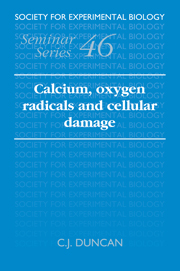Book contents
- Frontmatter
- Contents
- List of Contributors
- Preface
- 1 Are there common biochemical pathways in cell damage and cell death?
- 2 Free radicals in the pathogenesis of tissue damage
- 3 Calcium and signal transduction in oxidative cell damage
- 4 Regulation of neutrophil oxidant production
- 5 Reperfusion arrhythmias: role of oxidant stress
- 6 Biochemical pathways that lead to the release of cytosolic proteins in the perfused rat heart
- 7 Malignant hyperthermia: the roles of free radicals and calcium?
- 8 Free radicals, calcium and damage in dystrophic and normal skeletal muscle
- 9 Ultrastructural changes in mitochondria during rapid damage triggered by calcium
- 10 The importance of oxygen free radicals, iron and calcium in renal ischaemia
- 11 The Rubicon Hypothesis: a quantal framework for understanding the molecular pathway of cell activation and injury
- Index
7 - Malignant hyperthermia: the roles of free radicals and calcium?
Published online by Cambridge University Press: 18 January 2010
- Frontmatter
- Contents
- List of Contributors
- Preface
- 1 Are there common biochemical pathways in cell damage and cell death?
- 2 Free radicals in the pathogenesis of tissue damage
- 3 Calcium and signal transduction in oxidative cell damage
- 4 Regulation of neutrophil oxidant production
- 5 Reperfusion arrhythmias: role of oxidant stress
- 6 Biochemical pathways that lead to the release of cytosolic proteins in the perfused rat heart
- 7 Malignant hyperthermia: the roles of free radicals and calcium?
- 8 Free radicals, calcium and damage in dystrophic and normal skeletal muscle
- 9 Ultrastructural changes in mitochondria during rapid damage triggered by calcium
- 10 The importance of oxygen free radicals, iron and calcium in renal ischaemia
- 11 The Rubicon Hypothesis: a quantal framework for understanding the molecular pathway of cell activation and injury
- Index
Summary
Introduction
Malignant hyperthermia (MH) is an inherited disorder which predisposes sufferers to skeletal muscle hypercontraction, severe metabolic acidosis and a potentially lethal hyperthermia (Britt, 1985; McGrath, 1986; Sessler, 1986; O'Brien, 1987; Gronert, Mott & Lee, 1988; Harriman, 1988; Heffron, 1988; Rosenberg, 1988). In man, MH is usually triggered in susceptible individuals by halothane anaesthesia. A similar condition occurring in pigs is called the porcine stress syndrome (PSS). In response to halothane such PSS-susceptible pigs quickly develop a tachycardia and hyperventilate. Cyanotic areas then form on the skin, muscles hypercontract, limb rigidity occurs and a fatal hyperthermia ensues. Postmortem reveals oedematous, malodourous muscle with a severely disrupted structure. This meat is termed pale soft exudative (PSE) and cannot be used commercially. As well as halothane, stresses caused by transportation, exercise, feeding, mating and parturition will cause the development of a MH attack in pigs (Mitchell & Heffron, 1982).
PSS is regarded as a good model for human MH (Gronert, 1980) and has been used for much of the research into the mechanisms and causes of the disease. There is no uncomplicated and reliable diagnostic test for MH/PSS. Induction of limb rigidity by halothane inhalation will identify PSS-susceptible individuals and cause only limited mortality when performed by a skilled operator (Webb, 1980). In humans the disease is often recognised in a family when one person undergoes halothane anaesthesia prior to a surgical procedure. Thereafter muscle samples from other members of the family can be subjected to in vitro contracture tests to identify abnormal reaction to either halothane or caffeine.
- Type
- Chapter
- Information
- Calcium, Oxygen Radicals and Cellular Damage , pp. 115 - 138Publisher: Cambridge University PressPrint publication year: 1991
- 1
- Cited by



